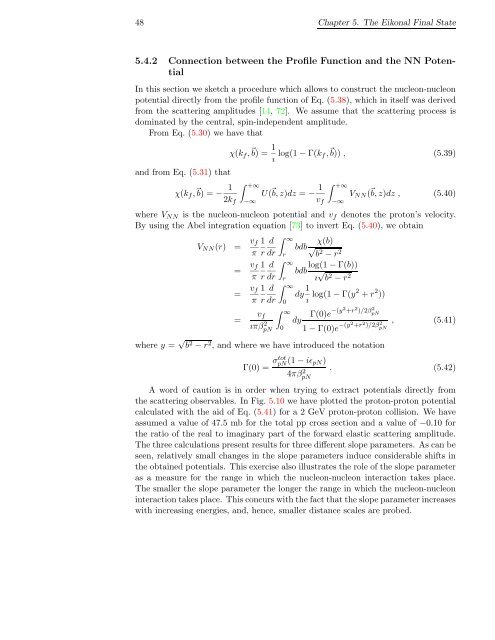Download Thesis in Pdf Format - Theoretical Nuclear Physics and ...
Download Thesis in Pdf Format - Theoretical Nuclear Physics and ...
Download Thesis in Pdf Format - Theoretical Nuclear Physics and ...
Create successful ePaper yourself
Turn your PDF publications into a flip-book with our unique Google optimized e-Paper software.
48 Chapter 5. The Eikonal F<strong>in</strong>al State<br />
5.4.2 Connection between the Profile Function <strong>and</strong> the NN Potential<br />
In this section we sketch a procedure which allows to construct the nucleon-nucleon<br />
potential directly from the profile function of Eq. (5.38), which <strong>in</strong> itself was derived<br />
from the scatter<strong>in</strong>g amplitudes [14, 72]. We assume that the scatter<strong>in</strong>g process is<br />
dom<strong>in</strong>ated by the central, sp<strong>in</strong>-<strong>in</strong>dependent amplitude.<br />
From Eq. (5.30) we have that<br />
<strong>and</strong> from Eq. (5.31) that<br />
χ(k f , ⃗ b) = 1 ı log(1 − Γ(k f , ⃗ b)) , (5.39)<br />
χ(k f , ⃗ b) = − 1 ∫ +∞<br />
U(<br />
2k ⃗ b, z)dz = − 1 ∫ +∞<br />
V NN (<br />
f v ⃗ b, z)dz , (5.40)<br />
f<br />
−∞<br />
where V NN is the nucleon-nucleon potential <strong>and</strong> v f denotes the proton’s velocity.<br />
By us<strong>in</strong>g the Abel <strong>in</strong>tegration equation [73] to <strong>in</strong>vert Eq. (5.40), we obta<strong>in</strong><br />
V NN (r) = v f<br />
π<br />
= v f<br />
π<br />
= v f<br />
π<br />
=<br />
1 d<br />
r dr<br />
1 d<br />
r dr<br />
1 d<br />
r dr<br />
v f<br />
ıπβ 2 pN<br />
∫ ∞<br />
r<br />
∫ ∞<br />
r<br />
∫ ∞<br />
0<br />
∫ ∞<br />
0<br />
−∞<br />
χ(b)<br />
bdb√ b 2 − r 2<br />
log(1 − Γ(b))<br />
bdb<br />
ı √ b 2 − r 2<br />
dy 1 ı log(1 − Γ(y2 + r 2 ))<br />
Γ(0)e −(y2 +r 2 )/2βpN<br />
2<br />
dy<br />
, (5.41)<br />
1 − Γ(0)e −(y2 +r 2 )/2βpN<br />
2<br />
where y = √ b 2 − r 2 , <strong>and</strong> where we have <strong>in</strong>troduced the notation<br />
Γ(0) = σtot pN (1 − iɛ pN)<br />
4πβpN<br />
2 . (5.42)<br />
A word of caution is <strong>in</strong> order when try<strong>in</strong>g to extract potentials directly from<br />
the scatter<strong>in</strong>g observables. In Fig. 5.10 we have plotted the proton-proton potential<br />
calculated with the aid of Eq. (5.41) for a 2 GeV proton-proton collision. We have<br />
assumed a value of 47.5 mb for the total pp cross section <strong>and</strong> a value of −0.10 for<br />
the ratio of the real to imag<strong>in</strong>ary part of the forward elastic scatter<strong>in</strong>g amplitude.<br />
The three calculations present results for three different slope parameters. As can be<br />
seen, relatively small changes <strong>in</strong> the slope parameters <strong>in</strong>duce considerable shifts <strong>in</strong><br />
the obta<strong>in</strong>ed potentials. This exercise also illustrates the role of the slope parameter<br />
as a measure for the range <strong>in</strong> which the nucleon-nucleon <strong>in</strong>teraction takes place.<br />
The smaller the slope parameter the longer the range <strong>in</strong> which the nucleon-nucleon<br />
<strong>in</strong>teraction takes place. This concurs with the fact that the slope parameter <strong>in</strong>creases<br />
with <strong>in</strong>creas<strong>in</strong>g energies, <strong>and</strong>, hence, smaller distance scales are probed.















